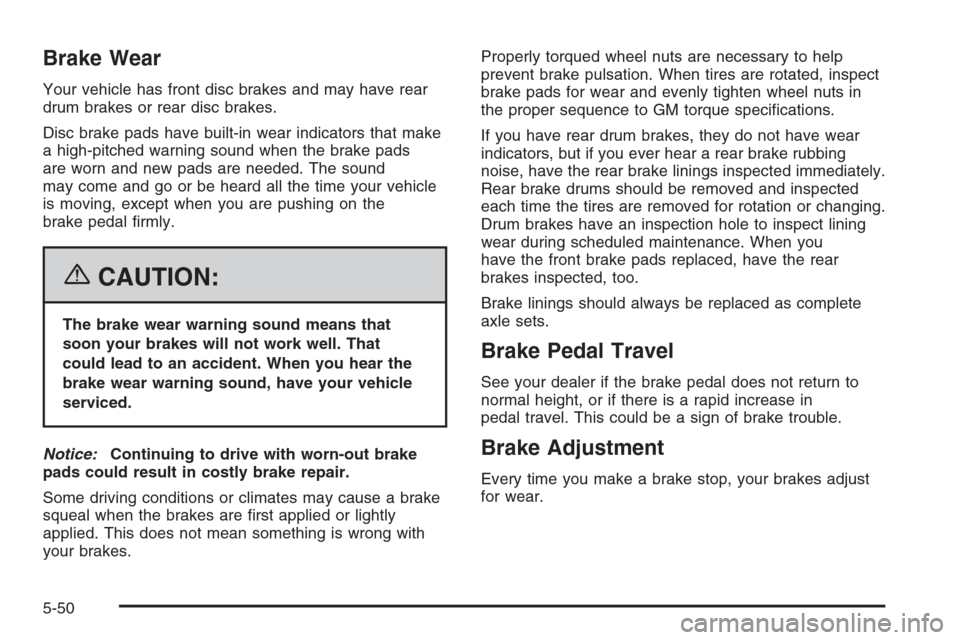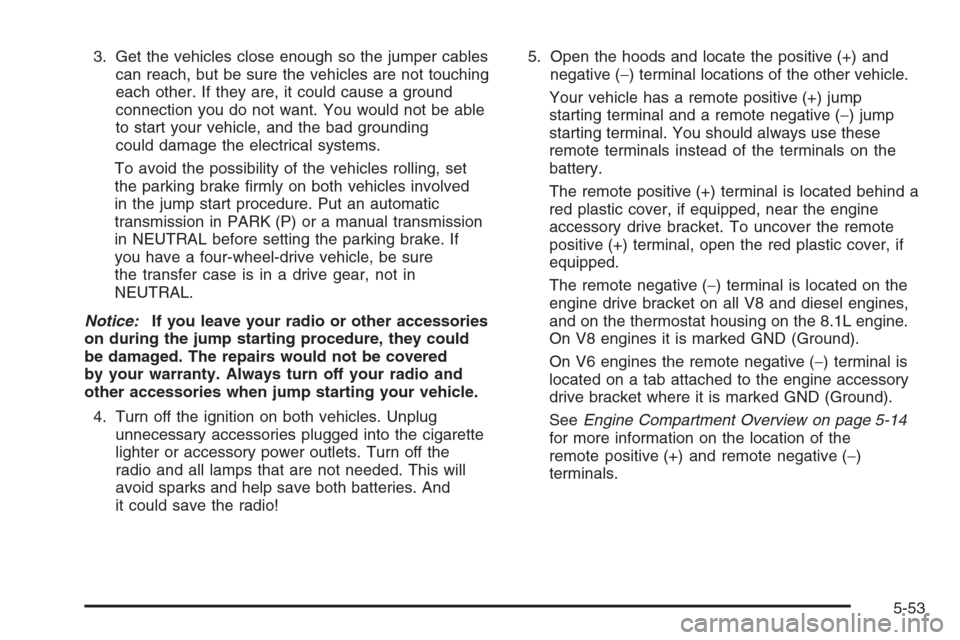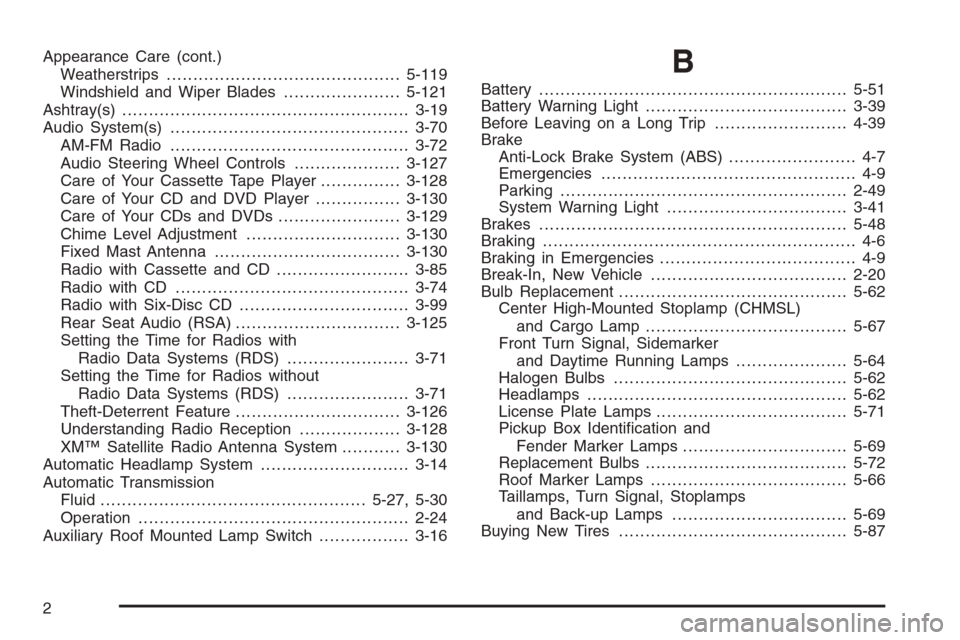2006 CHEVROLET SILVERADO brake light
[x] Cancel search: brake lightPage 454 of 594

Brake Wear
Your vehicle has front disc brakes and may have rear
drum brakes or rear disc brakes.
Disc brake pads have built-in wear indicators that make
a high-pitched warning sound when the brake pads
are worn and new pads are needed. The sound
may come and go or be heard all the time your vehicle
is moving, except when you are pushing on the
brake pedal �rmly.
{CAUTION:
The brake wear warning sound means that
soon your brakes will not work well. That
could lead to an accident. When you hear the
brake wear warning sound, have your vehicle
serviced.
Notice:Continuing to drive with worn-out brake
pads could result in costly brake repair.
Some driving conditions or climates may cause a brake
squeal when the brakes are �rst applied or lightly
applied. This does not mean something is wrong with
your brakes.Properly torqued wheel nuts are necessary to help
prevent brake pulsation. When tires are rotated, inspect
brake pads for wear and evenly tighten wheel nuts in
the proper sequence to GM torque speci�cations.
If you have rear drum brakes, they do not have wear
indicators, but if you ever hear a rear brake rubbing
noise, have the rear brake linings inspected immediately.
Rear brake drums should be removed and inspected
each time the tires are removed for rotation or changing.
Drum brakes have an inspection hole to inspect lining
wear during scheduled maintenance. When you
have the front brake pads replaced, have the rear
brakes inspected, too.
Brake linings should always be replaced as complete
axle sets.
Brake Pedal Travel
See your dealer if the brake pedal does not return to
normal height, or if there is a rapid increase in
pedal travel. This could be a sign of brake trouble.
Brake Adjustment
Every time you make a brake stop, your brakes adjust
for wear.
5-50
Page 457 of 594

3. Get the vehicles close enough so the jumper cables
can reach, but be sure the vehicles are not touching
each other. If they are, it could cause a ground
connection you do not want. You would not be able
to start your vehicle, and the bad grounding
could damage the electrical systems.
To avoid the possibility of the vehicles rolling, set
the parking brake �rmly on both vehicles involved
in the jump start procedure. Put an automatic
transmission in PARK (P) or a manual transmission
in NEUTRAL before setting the parking brake. If
you have a four-wheel-drive vehicle, be sure
the transfer case is in a drive gear, not in
NEUTRAL.
Notice:If you leave your radio or other accessories
on during the jump starting procedure, they could
be damaged. The repairs would not be covered
by your warranty. Always turn off your radio and
other accessories when jump starting your vehicle.
4. Turn off the ignition on both vehicles. Unplug
unnecessary accessories plugged into the cigarette
lighter or accessory power outlets. Turn off the
radio and all lamps that are not needed. This will
avoid sparks and help save both batteries. And
it could save the radio!5. Open the hoods and locate the positive (+) and
negative (−) terminal locations of the other vehicle.
Your vehicle has a remote positive (+) jump
starting terminal and a remote negative (−) jump
starting terminal. You should always use these
remote terminals instead of the terminals on the
battery.
The remote positive (+) terminal is located behind a
red plastic cover, if equipped, near the engine
accessory drive bracket. To uncover the remote
positive (+) terminal, open the red plastic cover, if
equipped.
The remote negative (−) terminal is located on the
engine drive bracket on all V8 and diesel engines,
and on the thermostat housing on the 8.1L engine.
On V8 engines it is marked GND (Ground).
On V6 engines the remote negative (−) terminal is
located on a tab attached to the engine accessory
drive bracket where it is marked GND (Ground).
SeeEngine Compartment Overview on page 5-14
for more information on the location of the
remote positive (+) and remote negative (−)
terminals.
5-53
Page 536 of 594

Fuses Usage
SEO B2 Off-Road Lamps
4WS Not Used
AUX PWRAuxiliary Power
Outlet — Console
PCM 1 Powertrain Control Module
ETC/ECMElectronic Throttle Control,
Electronic Brake
Controller-Gasoline Engine,
Fan Clutch-Diesel Engines
IGN EInstrument Panel Cluster, Air
Conditioning Relay, Turn
Signal/Hazard Switch,
Starter Relay
RTD Ride Control
TRL B/U Backup Lamps Trailer Wiring
F/PMP Fuel Pump (Relay)
B/U LPBack-up Lamps, Automatic
Transmission Shift Lock
Control System
RR DEFOG Rear Window Defogger
HDLP-HI Headlamp High Beam Relay
PRIME Not Used
AIRBAGSupplemental In�atable
Restraint System
FRT PARKFront Parking Lamps,
Sidemarker LampsFuses Usage
DRLDaytime Running
Lamps (Relay)
SEO IGN Rear Defog Relay
TBC IGN1 Truck Body Controller Ignition
HI HDLP-LT High Beam Headlamp-Left
LH HID Not Used
DRL Daytime Running Lamps
RVC Regulated Voltage Control
IPC/DICInstrument Panel
Cluster/Driver Information
Center
HVAC/ECAS Climate Control Controller
CIG LTR Cigarette Lighter
HI HDLP-RT High Beam Headlamp-Right
HDLP-LOW Headlamp Low Beam Relay
A/C COMPAir Conditioning
Compressor Relay
A/C COMP Air Conditioning Compressor
TCMB Transmission Control Module
RR WPR Not Used
RADIO Audio System
SEO B1Mid Bussed Electrical Center,
Rear Heated Seats,
Universal Home Remote
System
5-132
Page 579 of 594

A
Accessories and Modi�cations............................ 5-4
Accessory Power Outlet(s)...............................3-18
Adding a Snow Plow or Similar Equipment.........4-54
Additives, Fuel................................................. 5-7
Add-On Electrical Equipment...........................5-125
Air Cleaner/Filter, Engine.................................5-25
Air Conditioning..............................3-20, 3-21, 3-24
Airbag
Off Light.....................................................3-34
Passenger Status Indicator...........................3-36
Readiness Light..........................................3-33
Airbag Sensing and Diagnostic Module (SDM)...... 7-9
Airbag System................................................1-71
Adding Equipment to Your
Airbag-Equipped Vehicle............................1-87
Airbag Off Switch........................................1-78
How Does an Airbag Restrain?......................1-76
Passenger Sensing System...........................1-80
Servicing Your Airbag-Equipped Vehicle..........1-86
What Makes an Airbag In�ate?......................1-76Airbag System (cont.)
What Will You See After an Airbag In�ates?....1-76
When Should an Airbag In�ate?....................1-74
Where Are the Airbags?...............................1-72
Anti-Lock Brake System (ABS)........................... 4-7
Anti-Lock Brake, System Warning Light..............3-42
Appearance Care
Aluminum or Chrome-Plated Wheels.............5-121
Care of Safety Belts...................................5-119
Chemical Paint Spotting..............................5-123
Cleaning Exterior Lamps/Lenses..................5-120
Cleaning the Inside of Your Vehicle..............5-116
Fabric/Carpet............................................5-118
Finish Care...............................................5-120
Instrument Panel, Vinyl, and
Other Plastic Surfaces.............................5-119
Leather....................................................5-118
Sheet Metal Damage..................................5-122
Tires........................................................5-122
Underbody Maintenance.............................5-122
Vehicle Care/Appearance Materials...............5-123
Washing Your Vehicle.................................5-120
1
Page 580 of 594

Appearance Care (cont.)
Weatherstrips............................................5-119
Windshield and Wiper Blades......................5-121
Ashtray(s)......................................................3-19
Audio System(s).............................................3-70
AM-FM Radio.............................................3-72
Audio Steering Wheel Controls....................3-127
Care of Your Cassette Tape Player...............3-128
Care of Your CD and DVD Player................3-130
Care of Your CDs and DVDs .......................3-129
Chime Level Adjustment.............................3-130
Fixed Mast Antenna...................................3-130
Radio with Cassette and CD.........................3-85
Radio with CD............................................3-74
Radio with Six-Disc CD................................3-99
Rear Seat Audio (RSA)...............................3-125
Setting the Time for Radios with
Radio Data Systems (RDS).......................3-71
Setting the Time for Radios without
Radio Data Systems (RDS).......................3-71
Theft-Deterrent Feature...............................3-126
Understanding Radio Reception...................3-128
XM™ Satellite Radio Antenna System...........3-130
Automatic Headlamp System............................3-14
Automatic Transmission
Fluid..................................................5-27, 5-30
Operation...................................................2-24
Auxiliary Roof Mounted Lamp Switch.................3-16B
Battery..........................................................5-51
Battery Warning Light......................................3-39
Before Leaving on a Long Trip.........................4-39
Brake
Anti-Lock Brake System (ABS)........................ 4-7
Emergencies................................................ 4-9
Parking......................................................2-49
System Warning Light..................................3-41
Brakes..........................................................5-48
Braking........................................................... 4-6
Braking in Emergencies..................................... 4-9
Break-In, New Vehicle.....................................2-20
Bulb Replacement...........................................5-62
Center High-Mounted Stoplamp (CHMSL)
and Cargo Lamp......................................5-67
Front Turn Signal, Sidemarker
and Daytime Running Lamps.....................5-64
Halogen Bulbs............................................5-62
Headlamps.................................................5-62
License Plate Lamps....................................5-71
Pickup Box Identi�cation and
Fender Marker Lamps...............................5-69
Replacement Bulbs......................................5-72
Roof Marker Lamps.....................................5-66
Taillamps, Turn Signal, Stoplamps
and Back-up Lamps.................................5-69
Buying New Tires...........................................5-87
2
Page 586 of 594

L
Labeling, Tire Sidewall.....................................5-75
Lamps
Auxiliary Roof Mounted Lamp........................3-16
Cargo........................................................3-18
Dome ........................................................3-17
Dome Lamp Override...................................3-17
Fog ...........................................................3-16
Front Reading.............................................3-18
LATCH System
Child Restraints...........................................1-44
Latches, Seatback............................................ 1-9
License Plate Lamps.......................................5-71
Light
Airbag Off..................................................3-34
Airbag Readiness........................................3-33
Anti-Lock Brake System Warning...................3-42
Battery Warning..........................................3-39
Brake System Warning.................................3-41
Cargo Lamp...............................................3-49
Cruise Control.............................................3-48
Four-Wheel-Drive.........................................3-49
Highbeam On.............................................3-49
Low Fuel Warning.......................................3-50Light (cont.)
Malfunction Indicator....................................3-45
Passenger Airbag Status Indicator..................3-36
Safety Belt Reminder...................................3-33
Security.....................................................3-48
Tow/Haul Mode ...........................................3-49
Traction Off................................................3-42
Up-Shift.....................................................3-40
Lighting
Entry.........................................................3-18
Exit...........................................................3-18
Loading Your Vehicle.......................................4-48
Locking Rear Axle...........................................4-12
Locks
Delayed Locking........................................... 2-9
Door ........................................................... 2-8
Lockout Protection.......................................2-12
Power Door.................................................. 2-8
Programmable Automatic Door Locks.............2-10
Rear Door Security Locks.............................2-12
Loss of Control...............................................4-16
Low Fuel Warning Light...................................3-50
Lumbar
Power Controls............................................. 1-4
8